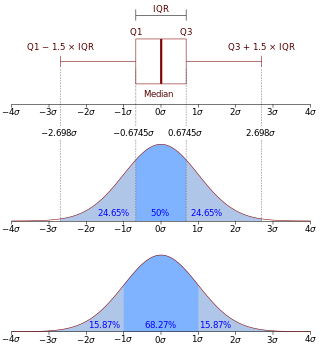逆威沙特分布| 参数 |
 自由度 (實數) 自由度 (實數)
 尺度矩陣 (正定) 尺度矩陣 (正定) |
|---|
| 值域 |
 是正定的 是正定的 |
|---|
| 概率密度函数 |
 |
|---|
| 期望值 |
 |
|---|
| 眾數 |
 [1]:406 [1]:406 |
|---|
逆威沙特分布,也叫反威沙特分布作是统计学中出现的一类概率分布函数,定义在实值的正定矩阵上。在贝叶斯统计中,逆威沙特分布會用作多变量正态分布协方差矩阵的共轭先验分布。
如果一个正定矩阵  的逆矩阵
的逆矩阵  遵从威沙特分布
遵从威沙特分布  的话,那么就说矩阵
的话,那么就说矩阵  遵从逆威沙特分布:
遵从逆威沙特分布:

逆威沙特分布的概率密度函数是:

其中  和
和  都是
都是  的正定矩阵,而Γp(·) 则是多变量伽马分布。函数
的正定矩阵,而Γp(·) 则是多变量伽马分布。函数

指的是迹函数。
设矩阵 并且
并且  是
是 的矩阵,那么
的矩阵,那么  遵从逆威沙特分布:
遵从逆威沙特分布: 。它的概率密度函数是:
。它的概率密度函数是:

其中  ,而
,而  是多变量伽马分布[2]。
是多变量伽马分布[2]。
设矩阵  遵从逆威沙特分布。并且假设矩阵
遵从逆威沙特分布。并且假设矩阵  和
和  都有相适合的分块矩阵表示方式:
都有相适合的分块矩阵表示方式:

其中子矩阵  和
和  是
是  的矩阵,那么会有:
的矩阵,那么会有:
甲) 和
和  与
与  相互独立,其中
相互独立,其中  是子矩阵
是子矩阵  在
在  中的舒尔补。
中的舒尔补。
乙)  ;
;
丙)  ,其中
,其中  是矩阵正态分布。
是矩阵正态分布。
丁)
假设要求先验分布  为逆威沙特分布
为逆威沙特分布  的协方差矩阵
的协方差矩阵 。如果观测值
。如果观测值
![{\displaystyle \mathbf {X} =[\mathbf {x} _{1},\ldots ,\mathbf {x} _{n}]}](https://wikimedia.org/api/rest_v1/media/math/render/svg/75115177c99d2884ec80cdacf66d2cf69caed817) 是从互相独立的 p-变量正态分布
是从互相独立的 p-变量正态分布  的随机变量得到的,那么条件分布
的随机变量得到的,那么条件分布
 遵从的是逆威沙特分布:
遵从的是逆威沙特分布: 。其中
。其中  是样本协方差矩阵的
是样本协方差矩阵的 倍。
倍。
因此,逆威沙特矩阵是多变量正态分布的共轭先验分布。
期望值:[2]:85

矩阵  的每一个系数的方差:
的每一个系数的方差:

对角系数的方差是在上式中令  得到,化简后变成:
得到,化简后变成:

当变量数目减到一个的时候,逆威沙特分布会变成特例:逆伽马分布。也就是说,当  、
、 、
、 以及
以及  的时候,逆威沙特分布的概率密度函数是:
的时候,逆威沙特分布的概率密度函数是:

这正是逆伽马分布。其中  是通常的伽马函数。
是通常的伽马函数。
而逆威沙特分布也有推广,其中一个是正态逆威沙特分布。






































![{\displaystyle \mathbf {X} =[\mathbf {x} _{1},\ldots ,\mathbf {x} _{n}]}](https://wikimedia.org/api/rest_v1/media/math/render/svg/75115177c99d2884ec80cdacf66d2cf69caed817)

















